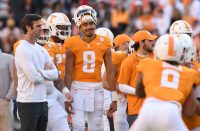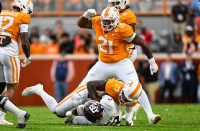There’s a temptation to say, “Anytime our defense doesn’t give up a touchdown, that’s a win.” It’s a reflection of the offense, currently operating at levels we really have no context for. My favorite stat of the moment: the national leaders in passing yards per attempt are two service academies with 71 combined throws in nine games.
The Vols are third, with 1,463 yards on 130 throws, 11.3 yards per attempt. Only three other teams are north of 10.
And Tennessee does all that while completing 73.8% of its passes, also third nationally. Only five other teams in America are yet to throw an interception, and again, one of them is a service academy. In efficiency, explosiveness, security, you name it, Tennessee is doing it better than anyone right now. It is truly remarkable.
So, when an offense does that, what does a defense need to do?
This is where small improvements can go a long way. And so far, one of the things Tennessee’s defense struggled with the most in 2021 has become a true strength in 2022.
Tennessee Red Zone Defense
- 2021: 50 red zone attempts, 46 scores (92%, 121st nationally), 36 TDs (72%, 119th nationally)
- 2022: 16 red zone attempts, 11 scores (69%, 16th nationally), 6 TDs (38%, 7th nationally)
The Vols have already turned teams away with no points more than they did in all of last season. When we wrote on this in the off-season, we talked about how even a small improvement here could be significant. And it’s not a statistic inflated by inferior competition: Ball State scored on both its red zone trips, Akron on two of three.
But we’ve seen both parts of a red zone defense’s strength in the power five games. At Pitt, the Panthers had five red zone visits but scored just a single touchdown. Against Florida, the Gators scored four red zone touchdowns, but came away with no points at all two other times: the fourth down stop on the game’s opening drive, and the forced fumble early in the fourth quarter.
(Tennessee’s offense, by the way: 22 red zone visits, 19 touchdowns and three field goals, getting points 100% of the time.)
The last Vol defense to keep opponents out of the end zone on more than half of their red zone visits: Monte Kiffin’s 2009 defense, which allowed 20 touchdowns on 44 visits (45%, 18th nationally). In the last ten years, only the 2015 defense hit better than 60% (23 touchdowns on 41 visits, 56%).
Tennessee’s defense has made a similar significant improvement on third down, so far giving up just 17-of-60 conversion attempts (28%, 16th nationally). But it doesn’t feel that way because teams are 8-of-13 on fourth down against UT. Those 13 attempts lead the nation among teams who’ve played only four games. I’m sure there’s a component here of offenses feeling like they have to try against us because of the potency of our own offense.
What does an offense like this need from its defense? If the Vols keep turning teams away in the red zone at a rate even close to 50% of the time, that could create all the separation we need. Tennessee still has just a pair of one-possession wins, but in SP+ they had a 92% win expectancy against the Gators, and 89% at Pitt. Translation: the Vols could be winning these games by even more, if we can avoid pesky things like fumbles and onside kicks.
For whatever conversation has taken place about what this defense can do better this week? It’s what they’re already doing so much better in the part of the field that matters most that should stand out more. It can help the offense continue to stretch their legs and their lead. And whether in Baton Rouge, against #1 Alabama or beyond, holding teams to three instead of seven (or continuing to turn them away entirely!) could keep making the difference in wins and losses for the undefeated Vols.





We have the SEC’s #1 red zone offense and LSU has the SEC’s #1 red zone defense. Will be an interesting Saturday.